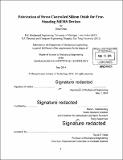| dc.contributor.advisor | Mark L. Schattenburg. | en_US |
| dc.contributor.author | Guan, Dong, S.M. Massachusetts Institute of Technology | en_US |
| dc.contributor.other | Massachusetts Institute of Technology. Department of Mechanical Engineering. | en_US |
| dc.date.accessioned | 2014-12-08T18:51:45Z | |
| dc.date.available | 2014-12-08T18:51:45Z | |
| dc.date.copyright | 2014 | en_US |
| dc.date.issued | 2014 | en_US |
| dc.identifier.uri | http://hdl.handle.net/1721.1/92141 | |
| dc.description | Thesis: S.M., Massachusetts Institute of Technology, Department of Mechanical Engineering, 2014. | en_US |
| dc.description | Cataloged from PDF version of thesis. | en_US |
| dc.description | Includes bibliographical references (pages 95-101). | en_US |
| dc.description.abstract | In development of the critical -angle transmission (CAT) grating, structural failure of the thin self-standing grating membrane posts a challenge for manufacturing yield. The major risk comes from the strongly compressive stressed buried oxide layer that creates loading to the thin silicon grating membranes. In an effort to find a solution, a process of fabricating silicon-on-insulator (SOI) wafers with tensile stressed buried oxide is studied in this work. Thin silicon dioxide films have been studied as a function of deposition parameters and annealing temperatures. Films were deposited by tetraethoxysilane (TEOS) dual-frequency plasma enhanced chemical vapor deposition (PECVD) with different time interval fractions of high frequency and low frequency plasma deposition. The samples were subsequently annealed up to 930 °C to investigate their stress behavior. Films that were deposited in high-frequency dominated plasma were found to have tensile residual stress after annealing at temperatures higher than 800 °C. The residual stress can be controlled to slightly tensile by changing the annealing temperature. Large-area free-standing tensile stressed oxide membranes without risk of buckling were successfully fabricated. A bonding process of the low tensile stressed oxide films into SOI wafers was developed. SOI wafers were successfully fabricated and examined by SEM inspection. The bonding surface energy was estimated from a double cantilever beam theory (razor blade method). The bonding strength satisfied the processing requirements of CAT grating fabrication. Other potential solutions to solve the problem of thin silicon grating membrane buckling are also presented. For obtaining tensile stress oxide films, a spin-on-glass approach was studied and showed promising results; an ion implantation approach is discussed with literature data. A different strategy for solving the buckled membrane challenge is processing with thick grating membranes for better structural robustness, then reducing membrane thickness by oxidation and vapor hydrofluoric etch. Proof-of-concept experiments were designed and carried out, which demonstrated capability to fabricate thick grating bars, to oxidize the silicon membrane into silicon dioxide with nanometer scale thickness control, and to etch the oxide with vapor hydrofluoric etch. | en_US |
| dc.description.statementofresponsibility | by Dong Guan. | en_US |
| dc.format.extent | 101 pages | en_US |
| dc.language.iso | eng | en_US |
| dc.publisher | Massachusetts Institute of Technology | en_US |
| dc.rights | M.I.T. theses are protected by copyright. They may be viewed from this source for any purpose, but reproduction or distribution in any format is prohibited without written permission. See provided URL for inquiries about permission. | en_US |
| dc.rights.uri | http://dspace.mit.edu/handle/1721.1/7582 | en_US |
| dc.subject | Mechanical Engineering. | en_US |
| dc.title | Fabrication of stress controlled silicon oxide for free- standing MEMS Devices | en_US |
| dc.type | Thesis | en_US |
| dc.description.degree | S.M. | en_US |
| dc.contributor.department | Massachusetts Institute of Technology. Department of Mechanical Engineering | |
| dc.identifier.oclc | 896378339 | en_US |
